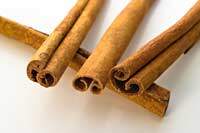
Cinnamon (Cinnamomum cassia, Cinnamomum zeylanicum), believed to have come originally from Sri Lanka, is the dried, fragrant bark of the cinnamon tree.
In the ancient world, cinnamon was more precious than gold – not too surprising though, as in Egypt gold was abundant and, thus, a fairly common ornamental metal.Nero, emperor of Rome in the first century A.D., burned a year’s supply of cinnamon on his wife’s funeral pyre — an extravagant gesture meant to signify the depth of his loss.
Egyptians used cinnamon medicinally to treat coughing, hoarseness and sore throats and as a flavoring for beverages. Because of its preservative qualities, the spice was rubbed into meats to inhibit bacterial growth, delaying spoilage, with the added bonus that the strong cinnamon aroma masked the stench of aged meats. It was also used in embalming,where body cavities were filled with spiced preservatives (mummification).
Preparation and Storage
Cinnamon comes in ‘quills’, strips of bark rolled one in another. Whole quills will keep their flavor indefinitely. Unfortunately it is difficult to grind, so for many recipes the powdered variety will be preferred. Like other powdered spices, cinnamon loses flavor quickly, so should be purchased in small quantities and kept away from light in airtight containers.
Medicinal Properties
Ironically, studies have found that cinnamon, a spice most often used in sweet confections, actually helps control blood sugar. People with Type II diabetes taking one gram (about 1/2 tsp.) of cinnamon a day for three months experienced a drop in blood sugar, according to a study published in the Journal of the American Board of Family Medicine (09/10/09). This amount of cinnamon per day also has been shown to reduce cholesterol (especially LDL or “bad cholesterol) and triglyceride levels by as much as 20% in Type II diabetes patients. Controlling diabetes can help prevent coronary artery disease and high blood pressure.
American researchers found that cinnamon may slow angiogenesis, the development of new blood supplies to tumors. Their conclusion, published in the journal Carcinogenesis, was that that an extract of the spice “could potentially be useful in cancer prevention and/or treatment.”
Cinnamon is being recommended to help curb the urge for tobacco. The National Institutes of Health (NIH) recommends chewing cinnamon sticks when trying to quit the use of tobacco. Another effective product that people use to help with overeating and tobacco use is cinnamon toothpicks.
Old folk remedies use cinnamon in preparations to combat diarrhea and morning sickness
because it’s a carminative (an agent that helps break up intestinal gas). Due to its mild astringency, it is particularly useful in infantile diarrhea. The spice is also a good source of manganese, fiber, iron, and calcium.
A study by Alan Hirsch, M.D. at the Smell and Taste Treatment and Research Foundation in Chicago found cinnamon scored high as an aphrodisiac for males. Another Study, conducted by Phillip R. Zoladz, Ph.D., assistant professor of psychology at Ohio Northern University, discovered that, after smelling or tasting cinnamon, students scored better on several mental performance tests, showing improved memory, more focused attention, faster reflexes. Researchers concluded that cinnamon has potential for decreasing test anxiety and even preventing age-related memory loss.
In the Kitchen
In Medieval Europe, Cinnamon was a staple ingredient, along with ginger, in many recipes. Since most meals were prepared in a single cauldron, casseroles containing both meat and fruit were common and cinnamon helped bridge the flavors. When the Christian Crusaders (11th – 13th centuries) brought home sugar, it too was added to the pot. Mince pie is a typical combination of this period, which still survives.
Today, cinnamon, is used in many dessert dishes — cakes and other baked goods, milk and rice puddings, chocolate dishes and fruit desserts, particularly apples and pears. In many Middle Eastern and North African dishes, it’s popular in flavoring lamb tagines or stuffed aubergines (eggplant). It is added to curries and pilau and in garam masala (Indian spice blend). It may be used to spice mulled wines, creams and syrups. The largest importer of Sri Lankan cinnamon is Mexico, where it is drunk with coffee and chocolate and brewed as a tea.
Sprinkle cinnamon onto apples, bananas, melons and oranges for a flavor kick. Add it to rice pilaf and stir it into hot cocoa. Mix cinnamon with mint and parsley in ground beef for burgers and meatloaf.
Sources:
The Epicentre: Encyclopedia of Spices
Healing Spices by Bharat Aggarwal, PhD (Sterling Publishing)
About.com: Homecooking




